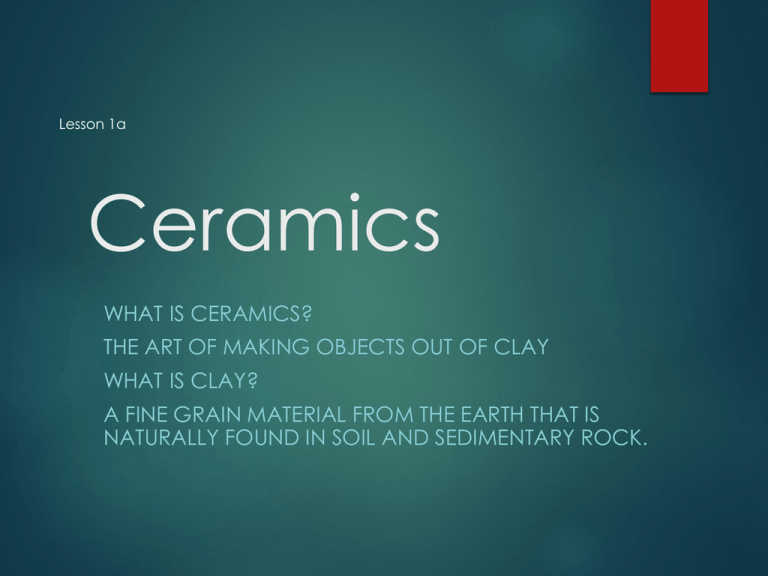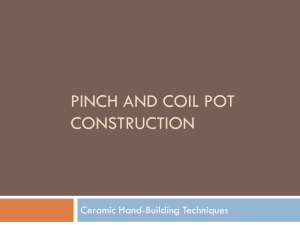Pinch Pots - SFP Online
advertisement

Lesson 1a Ceramics WHAT IS CERAMICS? THE ART OF MAKING OBJECTS OUT OF CLAY WHAT IS CLAY? A FINE GRAIN MATERIAL FROM THE EARTH THAT IS NATURALLY FOUND IN SOIL AND SEDIMENTARY ROCK. Hand building Techniques Pinch - Forming a clay object by pinching with the fingers. Slab - Forming a clay object from a flat piece of clay. Coil - Forming a clay object with ropes of clay Studio Rules Clay makes dust- all tables and equipment must be washed or wiped down with a wet sponge All tools must be cleaned free of clay All work should be wrapped in a plastic bag to slow the drying process. Do not handle any ones work other than your own. NO ONE IS ALLOWED TO LOAD OR UNLOAD THE KILN https://encryptedtbn0.gstatic.com/images?q=tbn:ANd9GcRjaZspjFV1WLK1syVb0LLrVOztYo2b5lJJ7l24tCJKDh7xWr- https://encryptedtbn1.gstatic.com/images?q=tbn:ANd9GcTAAwL4xXC2XRgKgzZVEKxgbhAt2_K3WVyeQYtehhwjM6DIlHhYg Pinch Pots HTTP://MEDIA-CACHEEC5.PINTEREST.COM/192X/6C/8D/29/6C8D2964032B472745E0CAFB7276D1D3.JPG Artist Takashi Murakami talks tea and ceramics Interview: Melanie Sevcenko http://www.dw.de/artist-takashi-murakami-talks-tea-and-ceramics/a-16541247 MELANIE SEVCENKO - HOW IS CERAMIC ART A PART OF JAPANESE HERITAGE? MURAKAMI - ONE OF THE TRADITIONAL ART FORMS OF JAPAN IS THE TEA CEREMONY. IN FEUDAL TIMES, THE TEA CEREMONY WAS DEVELOPED AS A WAY OF INCORPORATING THE ARTS INSPIRED BY ZEN BUDDHISM AND ITS PHILOSOPHY INTO A SOCIAL CUSTOM - WHICH MAKES IT A FAIRLY UNIQUE PIECE OF CULTURE. THE PRICE OF A SINGLE TEACUP REACHED AN EXTREMELY HIGH VALUE. WARLORDS WOULD HAVE THEIR CULTURAL REFINEMENT JUDGED BY THE QUALITY AND LINEAGE OF THEIR COLLECTIONS. IT'S REALLY QUITE SIMILAR TO TODAY'S CONTEMPORARY ART WORLD Japanese Tea Ceremony Chanoyu • The tea ceremony evolved with a greater significance in 1191 when a Zen priest traveled to China. • It is emphases of preparing and serving a bowl of tea with a pure heart • Based on the principles of Wa Kei Sei Jaku -harmony, respect, purity and tranquility “In all things, whatever they are, the finish of every detail is not desirable: Wabi-sabi one that holds the attention is unfinished ” ( The Book of Tea – Kakuzo Okakura ) Beauty of things: • Imperfect, and simple • Modest and humble • Unconventional Characteristics of wabi-sabi • Suggestion of natural process, irregular, earthy, simple • Embracing imperfection. Associated to the spiritual solitude of Zen Buddhism http://www.veniceclayartists.com/wpcontent/uploads/2012/11/Margaret_Curtis1101-300x238.jpg ‘Visual characteristics match its physical characteristics (if it looks heavy, it should feel heavy; if it looks delicate, it should feel light) Fits comfortably in the palm of your hand with a sound, balanced foot The rim should be rounded’ http://www.veniceclayartists.com/wpcontent/uploads/2012/11/Charles-Bound-Ceramic-TeaB.jpg http://www.veniceclayartists.com/wpcontent/uploads/2012/11/chawan14a.jpg http://www.veniceclayartists.com/wpcontent/uploads/2012/11/Marion-Angelica-Celadon-Do.jpg http://www.veniceclayartists.com/wp-content/uploads/2012/11/art-and-thespirit-of-tea-.jpg Pinch Pot requirements Three tea cups exploring different shape and form. Start with 4-5, 1 pound ball of clay The walls of your cup should be not be thicker than ¼ inch but no thinner than an 1/8 inch. The interior of the cup must be smooth. Your pinch pot must have a body, lip, and a foot Each cup should demonstrate a variety of surface technique The design of your cups must include pattern, repetition, texture and embrace nature Parts of tea bowl LIP - THE TOP EDGE OF A POT OR CUP BODY OF A POT -THE BELLY OF A POT OR CUP FOOT - THE BOTTOM OF A POT How to make a pinch pot Start with a ball of clay. Hold the clay in one hand while creating a well in the center of the ball with the thumb of the other hand. Careful! Not too deep or you might push through the bottom of the pot. Start at the bottom of the bowl and gently and evenly pinch the clay upward in a tight overlapping spiral. Make a complete rotation for each row of finger pinches. Each row should slightly overlap. If the clay begins to crack, moisten your fingers. Let the clay stiffen slightly, pinch the walls thinner and give the rim it’s final shape. Smooth the interior and exterior surfaces with a rubber rib or wooden tool. Using paddles, loop tools, wire, and other tools create patterns and textures on the exterior. Roll out an even coil for the foot. Score and add slip to the two surface that will be attached. Apply the foot and smooth out the joint. Lesson 1b Takashi Murakami Ceramics http://www.dw.de/image/0,,16542035_401,00.jpg http://www.dw.de/image/0,,16542054_403,00.jpg Winter and Summer Tea bowls How are they different? http://ts4.mm.bing.net/th?id=H .4845437015163503&pid=1.7& w=146&h=141&c=7&rs=1 http://www.asianart.com/BachmannEckenstein/large/Det ail1_1385-1-3_(Custom).jpg Aesthetics Aesthetics • Value and beauty as they relate to visual art Japanese Aesthetics • Influenced by Chinese culture and Buddhism • Influences by nature and environment • Simplicity and harmony Wabi-Sabi • Wabi – inner nature • Sabi- outer nature http://www.banninghs.org/ourpages/auto/2011/9/20/52761917/pinchpo ts%20and%20tea%20bowls.ppt Japanese Tea Bowls Lesson 1c http://pgapworld.wikispaces.com/file/view/japanese-tea-bowl.jpg/45859707/japanese-tea-bowl.jpg http://asia.si.edu/exhibitions/online/kenzan/images/F1911.jpg Studio equipment Slab roller- to create unifies slabs of clay Wheel – a tool to create cylindrical forms Kiln- an oven that reaches very high temperature Studio Rules 1. Clay makes dust- all tables and equipment must be washed or wiped down with a wet sponge 2. All tools must be cleaned free of clay 3. All work should be wrapped in a plastic bag to slow the drying process. 4. Do not handle any ones work other than your own. 5. NO ONE IS ALLOWED TO LOAD OR UNLOAD THE KILN Basic Ceramic terms • Ceramics - The art of making objects out of clay • Clay- A fine grain material from the earth that is naturally found in soil and sedimentary rock. • Pinch - Forming a clay object by pinching with the fingers. • Slab - Forming a clay object from a flat piece of clay. • Coil - Forming a clay object with ropes of clay • Bisque — unglazed pottery after first firing • Fire — a term used in ceramics; to heat the clay in a kiln at a very high temperature until it is dry and hard and becomes pottery. • Score — to scratch or “rough up” surfaces of clay that are to be joined together. • Scoring — a method of joining two parts of clay together that have dried to a leather hard stage by scratching the two. surfaces and spreading slip between them as a “glue.” • Slip — clay that has been watered down to a creamy consistency • Leather Hard – a drying stage of clay that allow the artist to create different forms different than wet clay. • Bone dry – a completely dry stage of clay • Green ware- ceramics that has not yet been fired. • Bisques ware – ceramics that has been fired once at a low temperature









